Jesse Sylvester Anderson was born on May 1st 1873 in Bear Lake, Michigan. At least, this is what he claimed for most of his life. However, the 1880 US census claims that he was born in Canada sometime in 1877. His parents John and Margaret Anderson were both from Canada, had married there in 1871 and immigrated to Michigan sometime between then and 1880. Jesse was the middle child of four siblings, and the son of a farmer.
In a 1922 article on Anderson’s life and work, Roy McCardell gave the following account of Jesse Anderson’s boyhood:
“Vet Anderson was born at Bear Lake, Michigan, a little lumber mill and shingle factory village 200 miles northwest of Detroit, some forty odd years ago. His people were farmers and he was a farmer’s boy from as early as he can remember up until the time he was 23.
His first memory of school was being handed a slate and pencil and at the age of 5 immediately drawing a horse on the slate and being spanked with a ruler by his bewhiskered, bewildered teacher who considered the uncanny ability of the child as a demonstration of devilry – witchcraft at the very least.
He attended the log cabin school until he was 12, and only indulged in his art impulses surreptitiously during the scholastic hours in all that time. But in his leisure moments at home he still expressed himself in art by drawing with sharpened sticks on the large tree lichens, or as they were called there, “tree toad-stool”. Some of these lichens grew of great size. A foot long and eight inches wide, in the shape of clam shells with smooth, white velvety surfaces when fresh from the tree.
The sharp stick left traces that turned dark brown, and many specimens of the young farmer woodsman’s art efforts on these large lichens are still treasured by friends and relatives in the Bear Lake district. Mostly they were genre and nature studies of homely farm scenes or the birds and beasts of Michigan.”
In 1891, the entire Anderson family left Bear Lake. John and Margaret returned to Canada, while Jesse, encountering the Railroad for the first time, journeyed to Big Rapids, another small Michigan shingle factory town. Here he studied bookkeeping at a small industrial school. When the instructor noticed Anderson doodling cows, horses, and caricatures on his lesson pad with remarkable skill, he convinced Anderson to give up bookkeeping and teach art.
Anderson taught drawing at this school (The Ferris Industrial School) for two years, then left in 1893 to take in the Chicago World’s Fair. While attending the fair, Anderson claimed to have made over 800 study sketches of the paintings and sculptures that had inspired him the most. For a Michigan farm boy aspiring to be a fine artist, this exposure to hundreds of ancient and modern masterworks of many nations was quite an incredible and influential experience.
Anderson returned to Bear Lake in 1893 and worked as a farmer for the next five years. He enlisted in the U.S. Military in April 1898, after reportedly pestering them with requests to enlist for about three months. However, he never saw action, instead spending six months in training at a camp near Washington. He was discharged on December 13th 1898, and travelled to Detroit in his tattered uniform, which he claimed was his only suit of clothes. It was due to this that he earned the nickname “Vet”, as it was quite unusual to see a young man dressed this way working in the art room of a metropolitan newspaper. “Vet” began contributing drawings to various Detroit papers at this time, around January 1899.
After a short stint at the Chicago Journal, Vet joined the staff of the NY Herald-Tribune around 1901. Here he contributed full page caricatures to the paper’s Sunday section for $30 a week. He also drew a short lived weekly comic strip “Hardy Hiram” in 1902. It was at the Tribune that Anderson developed his famous signature, consisting of a bird with large tail feathers forming his nickname “Vet”. In a 1958 interview Anderson recalled Frederick Opper, Jimmy Swinnerton, “Tad” Dorgan, Richard Oultcault, and Charles Dana Gibson as some of his close friends during his early rise to fame in NYC.
Anderson eventually left the Tribune for the NY Telegram, and then the NY World. At this time in the early 1900s Anderson also began gaining a national exposure through freelancing to noted humor magazines such as Puck and Judge, as well as other illustration projects. The 1908 dark humor novel “The Devil’s Notebook”, penned by Oliver Bainbridge, contains some of Vet’s most striking drawing.

1913 Ad for the Vet Anderson school
In 1913, Vet began advertising the “Vet Anderson School of Illustrating”, a by-mail correspondence course personally taught by Vet himself. I have not found advertisements for this service after 1913. By Spring 1916, Vet was on staff animating for Charles Bowers and Raoul Barre at their studio in the Fordham section of the Bronx. Dick Huemer recalled an incident involving Vet and a model that occurred at one of Barre’s model drawing seminars hosted after work hours:
“One night, right in the middle of the session while everyone was scratching away industriously, the model suddenly got down off her stand and flounced out of the room – anyway, as much as a gal with out any clothes on can be said to flounce. Barre, as much astonished as any of us, immediately followed her. And for a while we could hear them arguing back and forth, although we couldn’t make out what was said.
After a while, Barre came back with an amused smile on his rotund face and told us that classes were cancelled for that evening. Then he looked significantly at Vet Anderson. Vet, so-called because he was a veteran not of the Civil War but the Spanish American, was a well-known cartoonist of the early nineteen hundreds. His drawings appeared in such magazines as Puck, Judge and Life. He had now given that all up and turned to the new animated cartoons.
We all laughed when Barre told us it was all on account of Vet. “It’s that man,” she had said angrily. “He sits there drawing with that evil smirk on his face. What kind of a place is this anyway? Are you artists or a bunch of lechers who only want to look at a naked woman?”
Nothing that Barre could say had convinced her that Vet couldn’t help himself, that he always wore that satyric leer when he concentrated. It was a peculiarity like that way he kept his pipe tobacco loose in his pockets. Intense participation distorted his features the way a violinist will grunt to himself while deeply engrossed in his playing.
At any rate, Barre could not persuade the gal that we weren’t all a passel of voyeurs. And when she had her clothes back on and her fee collected, she really did flounce. I must add that notwithstanding Vet’s continued presence at future drawing sessions we never again had that same difficulty with any of the models. Probably she was an amateur. But I do remember that she had a fine figure.“
Izzy Klein, also on staff at Barre’s, recalled that even Burton Gillette had great respect for Anderson:
“During the first week Burt Gillett pointed out in an awed whisper one of the animators. He was a stocky, bald headed man who had a perpetual grin on his face as he worked. “That man there… he is “Vet” Anderson”. I knew the name. “Vet” Anderson was a famous editorial cartoonist of that period. Every kid who wanted to be a cartoonist knew the work of Vet Anderson.”
When America joined the first World War, Anderson again felt an overwhelming sense of patriotic responsibility and attempted to enlist, leaving the Barre studio. However, he was told he was 15 days too old to re-enlist in the US Military. Anderson reportedly then convinced officers at the English War Office that he was Canadian, and was admitted into the British Camouflage Department. As in the Spanish American war he never actually saw combat, but instead spent time peeling potatoes in a Kitchen in Swanage, near the coasts of Dover.
After the war ended in 1919, Anderson travelled to London. He freelanced cartoons for unknown London newspapers at this time, and also animated a commissioned anti-prohibition cartoon for the brewing interests of England. Here he married a much younger English girl named Emily Joan Rees (born in 1895), and fathered a daughter, Loma, in 1922.
Anderson used the money he earned from animation and cartooning in London to study sculpture there, and then traveled to Paris to continue this pursuit. Anderson had some of his work exhibited in the 1922 Salon de Artists in Paris, most notably a sculpture known as “Memories”. The Santa Ana Register (as well as other papers the story was syndicated to) reported in June 1922:
“The talk of the Salon Des Artistes Francais, which has just opened its doors to art lovers, is the work of an american sculptor, Jesse S. Anderson of New York City.
This important work is called “Memories” and is an old woman’s head, with pictures in relief figuring in her hair – dream- pictures of an old lady looking back over a full life.
Twenty figures cover the head. On the upper part, in the head just drawn away from the forehead, are girlish ones representing her childhood. Then comes young maidenhood, a young couple kissing, placed very near the ear, as if the old lady were listening back for the sound of this very kiss. Another couple is entwined about the other ear, this time figures of later life. On the side are middle aged couples, with children, and farther back, running into the nape of the neck, are grand parents, with their offspring.
The face itself is an interesting one, with figures within it which must be carefully studied out like the faces in the moon.”
Anderson and his family sailed back to NYC in December 1922, arriving on December 13th. The Andersons took up residence in the Bronx once again, and the following year a second child, John, was born. Around 1923 Anderson joined Paul Terry’s Fables Studios as an animator. Anderson had formerly worked with Terry’s older brother John in the NY World bullpen, way back in 1907.
Anderson seems to have hit a bit of a streak of hard luck during the depression of the 1930s. On July 4th 1928 the Anderson family homestead, now in New Jersey, was burned to the ground by a stray firework. The family was on vacation in Atlantic City and unharmed, but they returned home to find all their possessions gone.
Not long after this, Anderson began to notice turmoil at his steady animation job. The Fables studio was renamed for owner Amedee Van Beuren in 1929 and underwent a series of regime changes between 1929 and its closure in 1936. Like many of the old time fables animators, Anderson fell out of favor when the studio converted to sound production. He was let go around Spring 1930 or earlier. Anderson joined Fleischer studios for a short period of time following this. Although he did not receive screen credit, his animation can be seen in the Talkartoon “Hide and Seek” and he is pictured in the 1930 Fleischer staff photo.
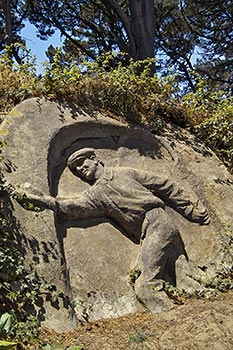
Andersons 1937 horseshoe pitcher statue reportedly still stands after a 2009 restoration
In the Summer of 1931, the Anderson family relocated to Los Angeles and Vet took a job animating for fellow NYC animation pioneers Walt Lantz and Bill Nolan. Vet stayed on staff for only about a year, as his archaic approach to animation was falling out of favor with the rapidly developing standards of the animation industry. Toward the end of his stay, Lantz and Nolan experimented with giving Vet only certain characters in a shot to animate and leaving Oswald or other “cute” characters to another animator with a more modern style. Here, as at Fables, his specialty was animating huge beasts and monstrous villains. He contributed animation to fellow Canadian animator Ted Eshbaugh’s Wizard of Oz short in 1933, as well as Eshbaugh’s The Snowman. These films contain the last known scenes animated by Anderson.
In June 1933, Anderson was admitted into a home for disabled volunteer soldiers. He’d been suffering from an ulcer as well as several other ailments. In 1937, he freelanced two sculptures for the WPA: a horseshoe pitcher and a horse for the newly installed horse shoe pitching pits at San Fransisco’s Golden Gate Park (where Anderson was a member of the horse shoe pitching club). Anderson eventually retired to San Jose, California. He died in Santa Clara on January 14th 1966 at the age of 93. I am not sure if Anderson continued working professionally as an artist after the 1930s, but in his last known interview (given in March 1958) he claimed that he was still sketching, despite a “bum left eye” which he complained “rather cramps his style”.
This video compiled by Devon Baxter from clips and music selected by Charlie Judkins
(Special thanks to Loma Anderson and Devon Baxter)


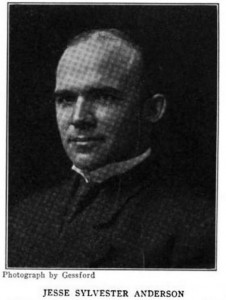

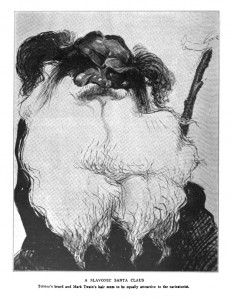
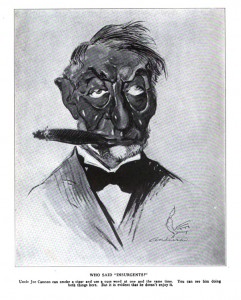
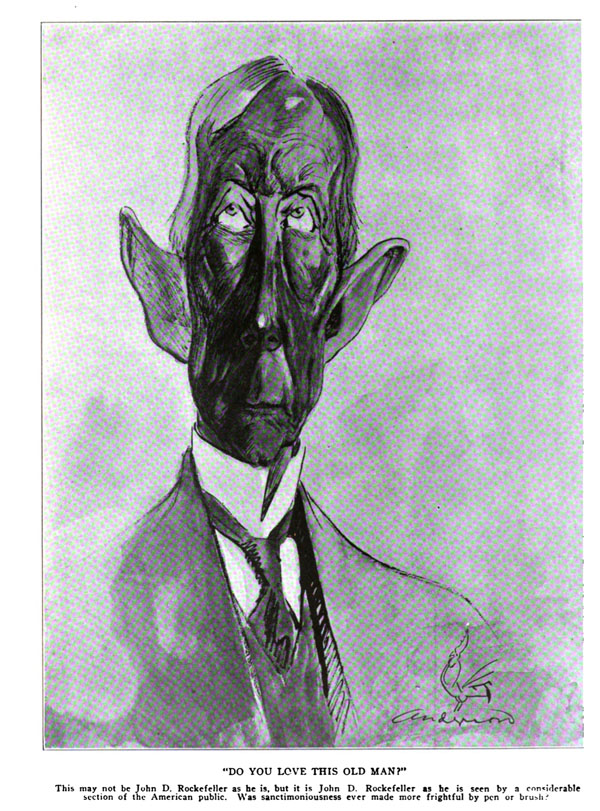
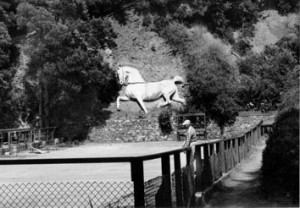
 Charlie Judkins is an animator and animation historian based in Brooklyn, NY. He also works as a Ragtime Pianist, and is the protege of Ragtime legend Terry Waldo.
Charlie Judkins is an animator and animation historian based in Brooklyn, NY. He also works as a Ragtime Pianist, and is the protege of Ragtime legend Terry Waldo.





































If he was given certain characters to do, does this mean he did the keyframes in addition to the in-betweens? Does this mean he would have been responsible for his individual character design? Are these cartoons pot luck creations in that regard?
I wish Cartoon Research could print a hardcopy annual for these articles. That would be a treasure. They read like Vasari’s Lives of the Artists.
(BTW that last bit of organ music was fantastic. Any chance of listing the performers/composers/sources?)
Well, the closes we have to hard copies are Korkis’ Animated Anedotes, but that would great to have.
I’m fairly certain that Vet animated straight ahead and did all his own inbetweens in the classic NYC method of animating. He didn’t contribute much character design at Lantz but he did some incidental character design on occasion at Fables.
The organ record is Hammond Olsen performing Clarinet Marmalade.
Another great early animator profile! I wish you could do Jerry Shields next! His funky old-timey animation and his life as a whole sparks interest.
Shields is one of my very favorite artists, but so much new information has come to light on his life and career that I have to save it for my upcoming book on NYC animation due out sometime next year. Whatever doesn’t fit in the book might make an interesting CR post though, I have thinking about doing a retrospective of Shields’ fine early work as a political and sports cartoonist.
Finally, my wish has come true. I asked for this a few years ago- and now, this. I’m impressed. I congratulate you, Jerry and Charlie, for the great wealth of information regarding “Vet”.
Hey Charlie:
Thanks for the fantastic article about Vet Anderson. I’ve enjoyed your past articles here and eagerly look forward to your upcoming profile of George Cannata and any future articles on other early-sound- or silent-era N.Y. animators (not to mention the upcoming book on N.Y. animation).
Speaking of Vet’s work at Fleischer, there’s an animator on the Screen Song And the Green Grass Grew All Around (released June 1, 1931) that I’m wondering about, specifically involving the final chorus sequence (4:54 up to 5:27 in the video, where there’s an animator change):
https://www.youtube.com/watch?v=3gA0p_CQ0JY
I’ve been studying the early ’30s Fleischer animators’ styles over the past several months and I haven’t seen this style in any other Fleischer cartoon released in 1930 or ’31. To my eyes, the drawing style and movement bear some resemblance to Vet’s work elsewhere (and if it’s not him, I have no idea who it is). The screen credits to this one are lost, so no help there.
What do you think about this??
The beginning of this one is animated by Al Eugster and Shamus Culhane, the last shot from 5 28 to 5 37 is by Rudy Zamora. The scene you’re asking about is a hard call, though. The bit with the cow and the uneven quality of the hopping bird’s eyes in a few shots makes me think Vet, but the smoothness of the stork’s wings doesn’t seem like his approach. It doesn’t really have the jittery quality Anderson’s animation usually has, so if it is Vet’s work it was probably heavily retouched by an assistant.
Thanks for the input. I’m a bit confused by your last sentence. According to Harvey Deneroff, the Fleischer studio did not have assistant animators in the early ’30s, except for Lillian Friedman for a short time in 1932 under Culhane. Just inbetweeners and the ink and paint department. Is this incorrect?
Charlie, what a terrific and valuable column! I’ve come across Vet in those early Oswald credits but truly have known very little about him. This is a watershed for me to know this backstory, and even just to imagine him sitting with his signature grin and animating straight-ahead alongside Nolan, Avery and others, his idiosyncratic style and preferences soon relegating him to a forgotten place in animation history. Thanks for shining light on his story, much appreciated.
What a great article! I found an original ink drawing signed by Vet in 1905 in an antique warehouse. It is a caricature of a pianist with wild flowing hair. I wish I knew who it was and what it was worth. I love it!!!
The pianist likely was Ignaz Paderewski, Polish master whose tours of the US at that time were sensational. Later he became leader of Poland. I just discovered this post. Today I am posting a Vet Anderson caricature of Mark Twain (emphasis on HIS flowing hair!) in the GOLDEN AGE OF ILLUSTRATION site on Facebook. I own the original art.
Anderson’s old at house at 101 N. 15th St. in San Jose still has some of his whimsical lawn sculpture.
His “Rabbit Ruff House” is a delight.